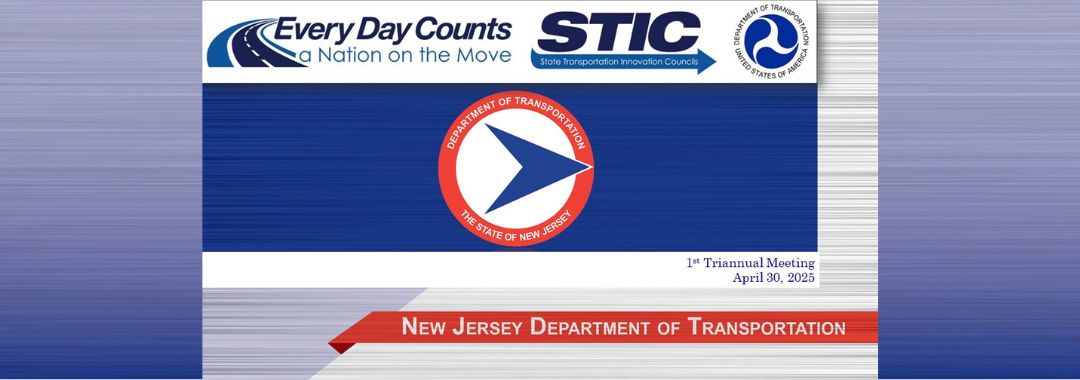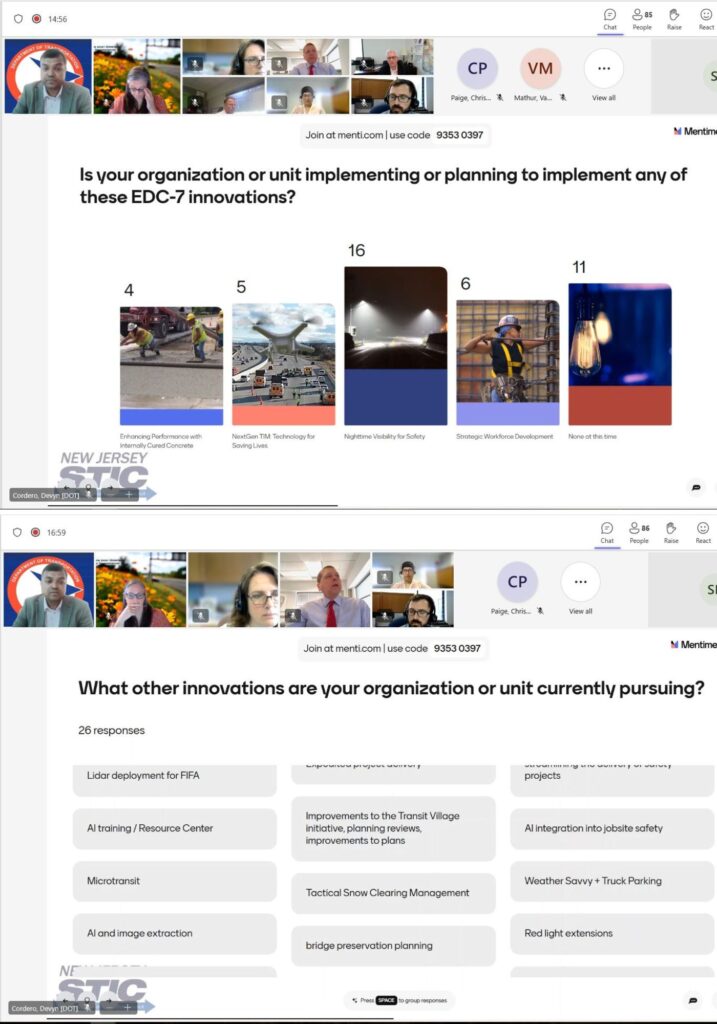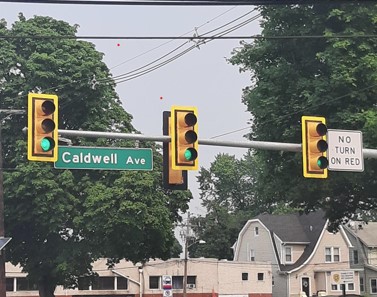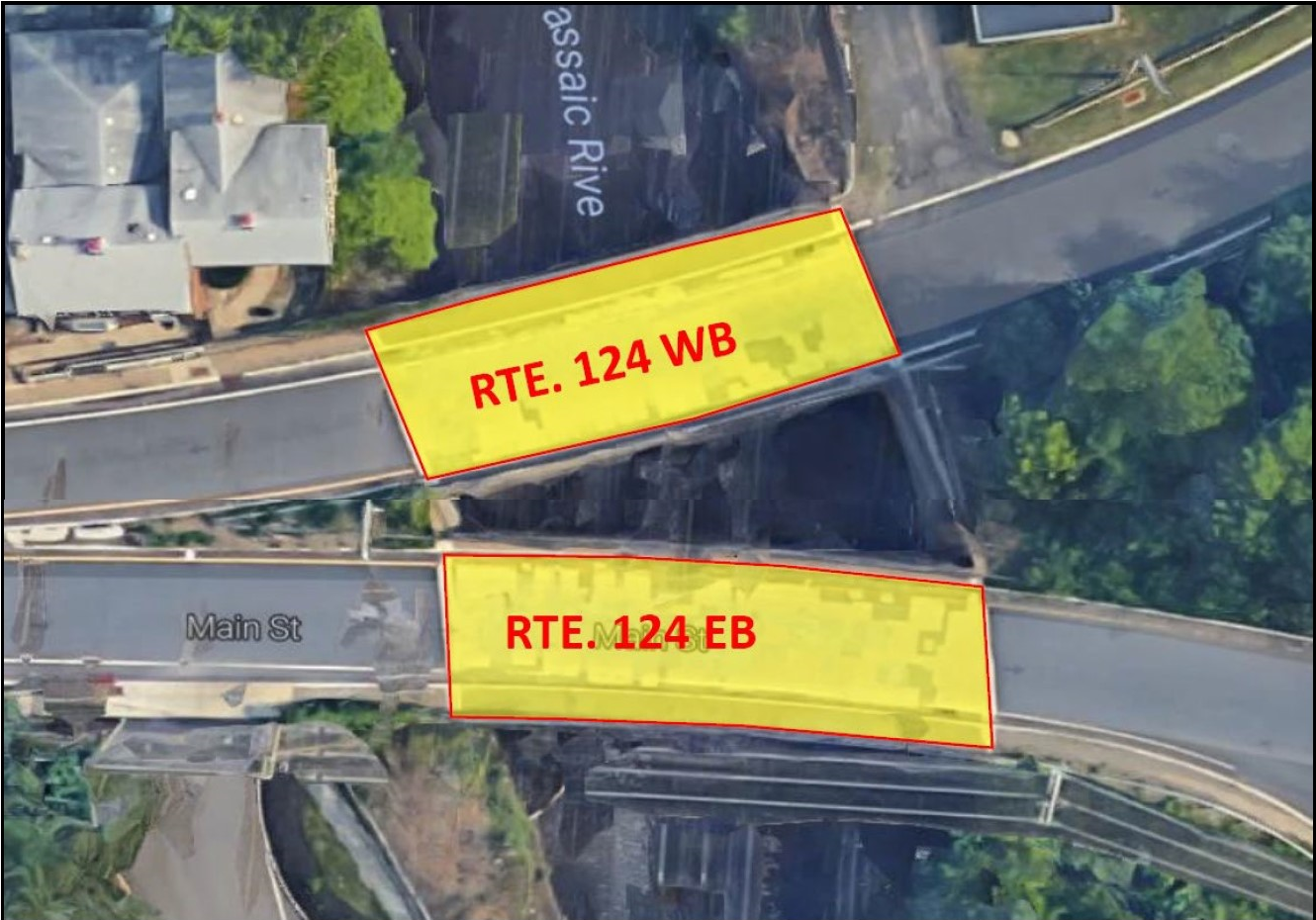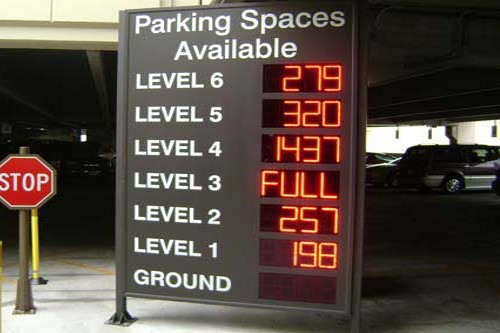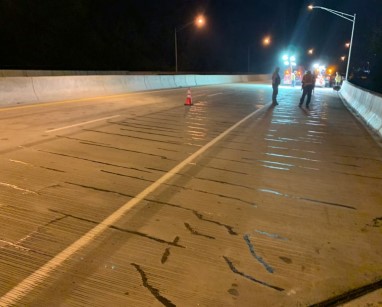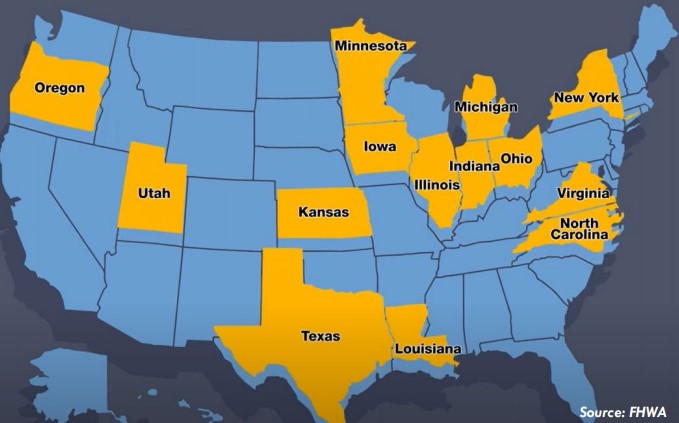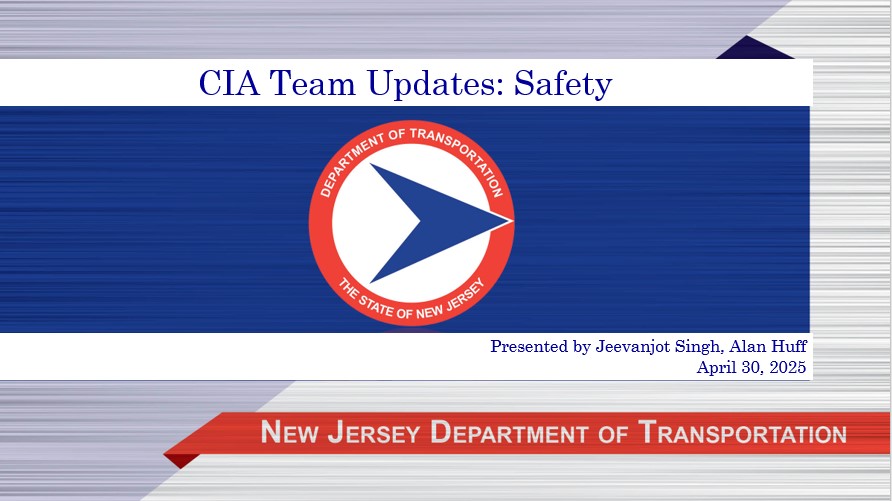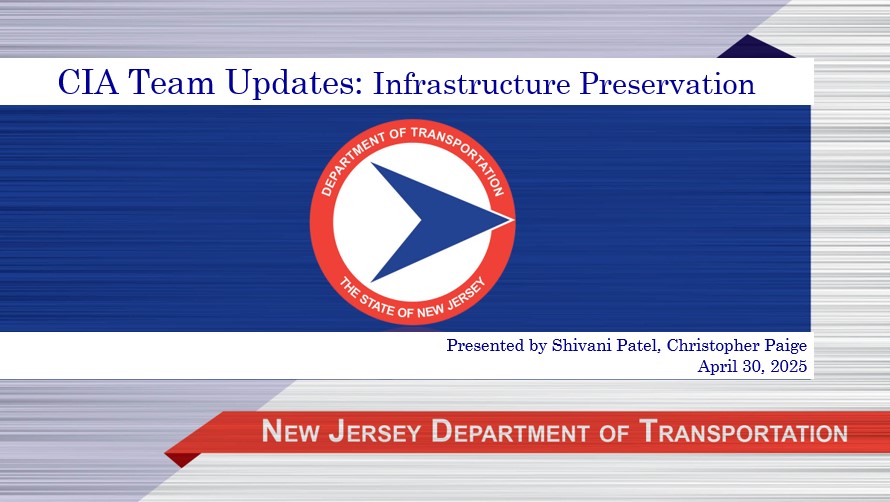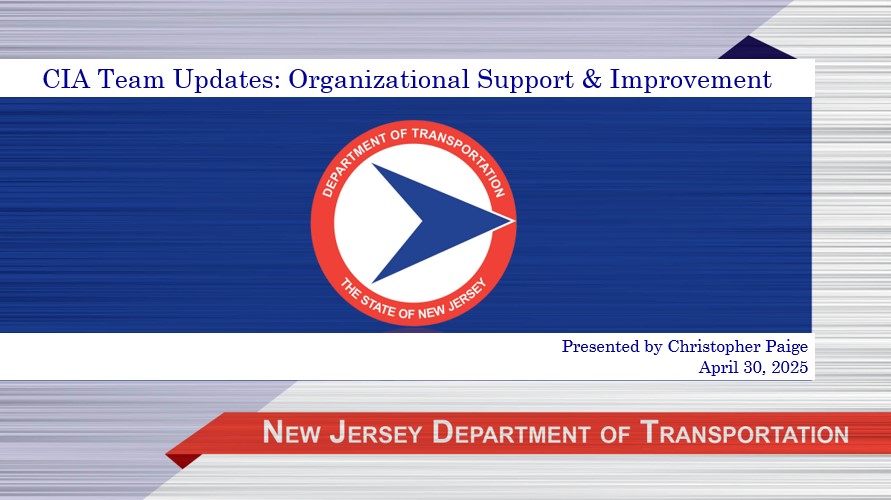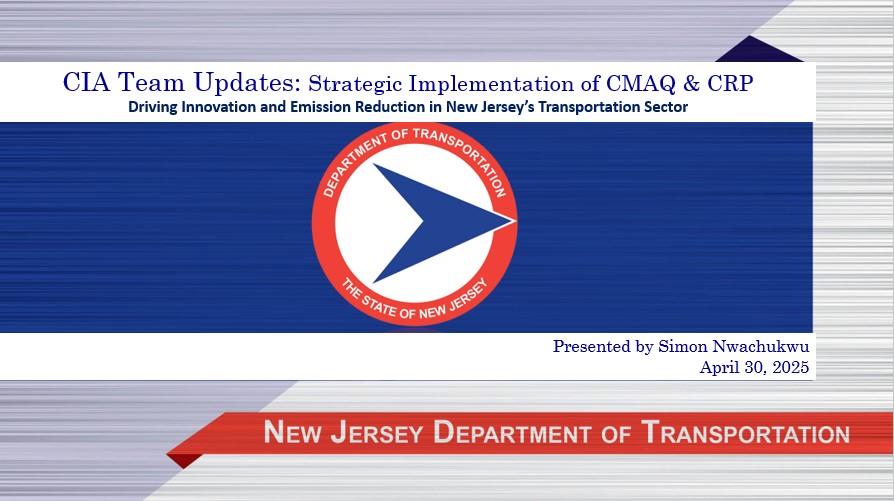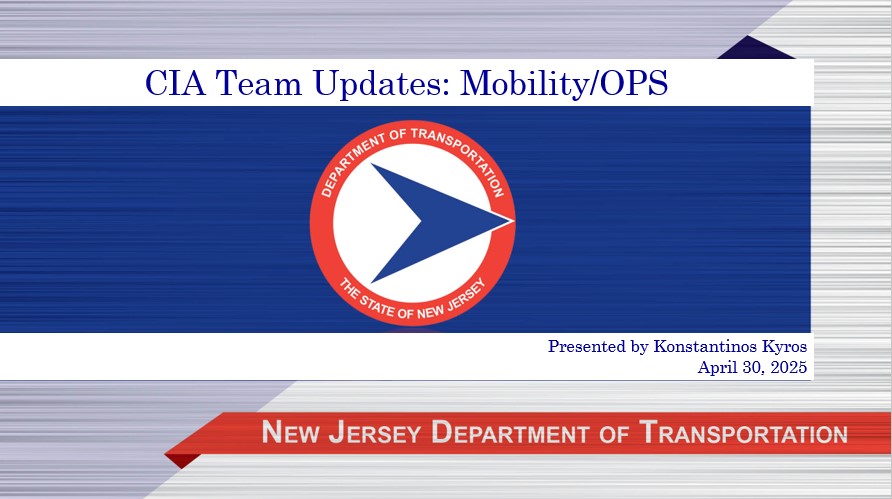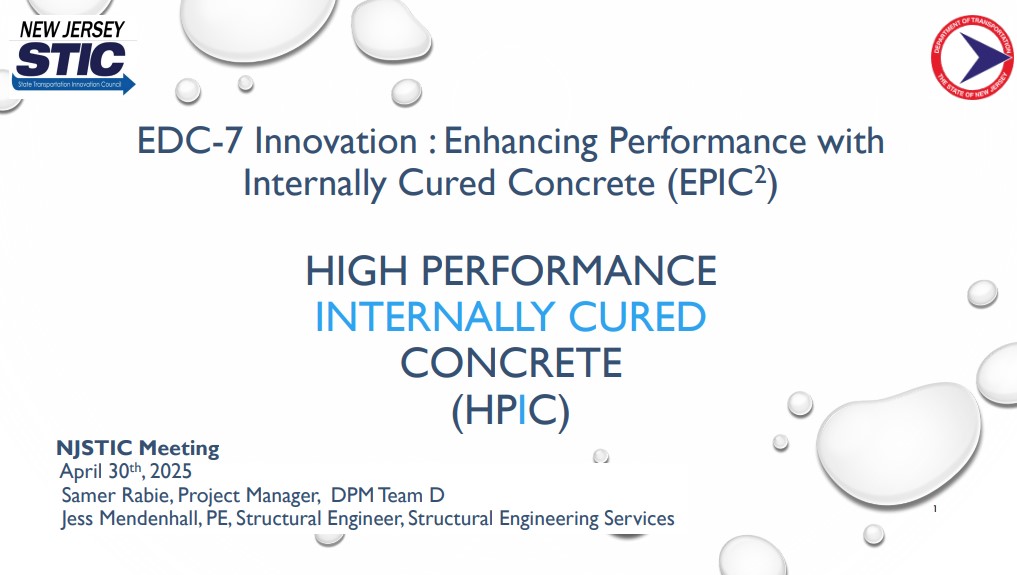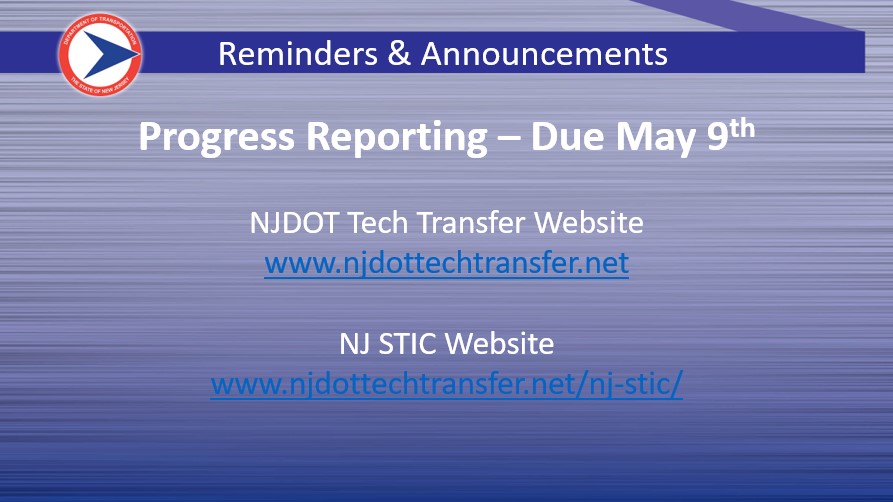The NJ State Transportation Innovation Council (NJ STIC) convened virtually for its first Triannual Meeting of 2025 on April 30. The meeting provided an opportunity for attendees to learn from the Core Innovation Area (CIA) Teams about their progress on the Every Day Counts Round 7 (EDC-7) initiatives and to view a featured presentation on High Performance Internally Cured Concrete (HPIC) from NJDOT’s Samer Rabie and Jess Mendenhall.
Welcome Remarks
Eric Powers, Assistant Commissioner of NJDOT Statewide Planning, Safety, and Capital Investment, welcomed attendees. Mr. Powers offered his gratitude to the NJ STIC community, emphasizing that the strength of STIC lies in the creativity and impact of its members. He concluded his remarks by stressing the meaningful contributions that CIA teams make in New Jersey, and officially opened the session.
FHWA Updates
Christopher Paige, Innovation Coordinator and Community Planner at the FHWA NJ Division Office, shared several key updates. He reminded attendees that final EDC-7 progress reports and STIC Incentive project reports should be directly submitted to him by May 9, 2025. Mr. Paige also announced that he will temporarily serve as the FHWA Co-Lead for the Infrastructure Preservation CIA team in collaboration with Shivani Patel, as well as on the Planning & Environment team with Simon Nwachukwu. Looking ahead, he stated that the FY25 STIC Incentive Funding Request applications are due by July 1, 2025, but encouraged early submissions. Applicants should include a project summary, schedule, and budget, and submit the application to Christopher Paige and NJDOT Innovation Officer Giri Venkiteela. Those interested in learning more about the application process for STIC funding should visit the STIC Incentive Funding Grant page on the NJDOT Tech Transfer website.
Mentimeter Engagement Activity
After the FHWA Updates, Giri Venkiteela, Innovation Officer at the NJDOT Bureau of Research, Innovation, and Information Transfer (BRIIT), hosted a Mentimeter Engagement Activity to learn the makeup of attendees, gauge their involvement with advancing innovation, and gather feedback on their current EDC initiatives. Questions included:
- Which agency type do you represent?
- What comes to mind when you think of innovation?
- Is your organization or unit implementing or planning to implement any of the EDC-7 innovations?
- What challenges are you facing in implementing innovations?
At the end of the survey, Mr. Venkiteela encouraged attendees to contact BRIIT staff if they had an innovation or research idea that they would like to propose to NJDOT.
Core Innovation Areas (CIA) Updates
The Core Innovation Area (CIA) Team leaders shared updates on progress toward achieving deployment goals for their respective innovation initiatives. CIA Team leaders from the NJDOT and FHWA discussed EDC-7 initiatives under the five CIA Teams: Safety, Planning and Environment, Infrastructure Preservation, Mobility and Operations, and Organizational Support and Improvement. Each team presented detailed reviews of their ongoing projects and outlined implementation activities, accomplishments, and challenges experienced in meeting the innovation’s deployment goals. A brief overview of team updates is included below:
Safety
Pedestrian Scale Lighting Research and Resource. Researchers at the Alan M. Voorhees Transportation Center at Rutgers University and Rowan University continue to finalize a resource on best practices for pedestrian scale lighting. The Safety Team stated that the guide, designed for county and local governments, still needs additional edits and review from NJDOT SMEs before it can be released as a final deliverable. Additionally, in January, FHWA delivered an in-depth, two-day lighting workshop in Bordentown to an audience of NJDOT, MPO, and municipality staff. Workshop topics included visibility, human factors, safety, cost-benefit analysis,
Nighttime Visibility for Safety. The Safety Team reported progress on developing traffic signal pole and mast arm details for signalized intersection installations based on 2015 AASHTO LRFD requirements. The Division of Traffic Engineering continues to install backplates with retroreflective tape on existing signal indications where feasible, and the design consultant for the initiative is coordinating with fabricators on manufacturing options.
Planning and Environment
Congestion Mitigation and Air Quality Improvement Program (CMAQ). NJDOT is actively approving new projects based on their alignment with CMAQ goals and federal air quality targets; the process includes a cost-effectiveness analysis, where projects must demonstrate potential to reduce congestion, mitigate environmental impacts, and advance the adoption of low emission technologies. Project types include: public transit expansion, intersection modernization, intelligent transportation systems, and low-emission vehicle incentives.
Carbon Reduction Program (CRP). The Planning and Environment Team also announced that the CRP has transitioned from the planning stage to full-scale implementation. Key strategic advancements made by NJDOT include the deployment of battery-electric buses, the development of Complete Streets initiatives, and partnerships with municipalities for the transition to green fleets. NJDOT evaluates the effectiveness of CRP projects using performance indicators like reductions in CO2, increased transit ridership, and improved air quality. The next steps for NJDOT are to accelerate CRP-backed projects, integrate AI-based traffic management systems to optimize traffic flow, and continue collaboration with MPOs, industry leaders, and research institutions.
Infrastructure Preservation
Enhancing Performance with Internally Cured Concrete (EPIC2). The Infrastructure Preservation Team has made progress on several initiatives to advance the EPIC2 program since the last STIC meeting. NJDOT’s Division of Procurement has posted the Request for Proposal (RFP) for a centrifuge apparatus and is currently awaiting bids. Verification testing for the High-Performance Internally Cured Concrete (HPIC) mix is underway on the program’s first pilot bridge in East Orange. In addition, six more pilot projects are in the final design stage, including a twin bridge pilot where one structure will use a traditional concrete mix as a control, while the other will incorporate the HPIC mix. Looking ahead, the team plans to complete a Final Design Submission for candidate bridges, begin scoping additional projects, and purchase the centrifuge apparatuses. Plans are also underway to host an EPIC2 workshop and a webinar, with dates to be determined.
Mobility and Operations
Weather Savvy. The Weather Savvy pilot has expanded from 24 to 45 vehicles since December 2023, with 44 currently active. The team has prioritized installations in plow trucks to allow for data collection during winter weather events. Hardware is now housed in a sealed junction box with a Plexiglas lid to prevent tampering and environmental damage. The team is also testing a new configuration that would enable data to stream directly from sensors to servers, improving the system’s efficiency.
Truck Parking Pilot. The Harding and Kearny Point locations continue to collect real-time truck parking data using cameras, remote traffic microwave sensors, and in-pavement micro radar sensors. The Mobility and Operations Team will soon install a portable dynamic message sign (DMS) five miles from the Harding rest area to inform drivers of available spaces. Additionally, NJDOT plans a third truck parking pilot site in Knowlton; the Mobility and Operations Team visited the Knowlton site on May 1.
Drivewyze Alerts. The Mobility and Operations Team also provided an update on the Drivewyze alert pilot. During the first round of testing in 2024, NJIT researchers received accurate static alerts, but no congestion alerts, prompting NJDOT and NJIT to conduct a second round of testing in April to verify the accuracy of the real-time congestion and slowdown alerts provided to drivers. The team awaits results for this phase of testing.
Vaisila GroundCast. NJDOT has installed Vaisala GroundCast, a wireless in-ground sensor system that provides long-term environmental data, at three locations (on NJ-29 and NJ-12) to measure road temperature and the amount of residual treatment material. The team is in the process of finalizing an additional location for installation.
Organizational Support and Improvement
Contractor Compliance Unit Collaboration. NJDOT continues to explore internal and external funding opportunities, including potential partnerships with the New Jersey Department of Labor and Workforce Development (NJDOL). NJDOL programs offer customizable transportation-related training and counseling services that could support NJDOT workforce needs. In March 2025, NJDOT met with the Contractor Compliance Unit to discuss union engagement, apprenticeship programs, strategies to address the aging workforce, and methods to increase membership. Upcoming outreach activities include an open house for individuals interested in working with NJDOT, and a contractor industry meeting scheduled for May 9.
Feature Presentation: High Performance Internally Cured Concrete (HPIC)
Samer Rabie and Jess Mendenhall, co-leads of the SME teams for both the EPIC2 EDC-7 initiative and the UHPC for Bridge Preservation and Repair EDC-6 initiative, delivered a comprehensive feature presentation explaining the principles of HPIC, demonstrating its significance for New Jersey, and highlighting NJDOT’s ongoing efforts to implement the use of this material.
Under current specifications, NJDOT utilizes high performance concrete (HPC) and ultra-high performance concrete (UHPC) for bridge decks. Both HPC and UHPC contain a low water-cement ratio and large amounts of supplementary cementitious materials (SCMs), which enhances durability but also increases the risk of shrinkage cracking. This early-age cracking undermines the improved durability and requires frequent and costly sealing.
FHWA launched the EPIC2 EDC-7 initiative in response to decades of research showing that HPIC effectively targets and mitigates shrinkage cracking in HPC and UHPC, resulting in low-permeability concrete with enhanced durability. HPIC employs internal curing, in which water is supplied from within the concrete using pre-wetted lightweight fine aggregate (LWFA). The absorbed water remains in the LWFA during mixing and until the concrete sets, leading to improved water distribution throughout the concrete and reducing the risk of cracking.
To date, internal curing has been implemented and institutionalized by more than 15 states and transportation agencies, and used in over 150 bridge decks. New York Department of Transportation (NYSDOT), an early adopter of HPIC, has mandated internal curing for all continuous bridges and bridges in New York City, reporting no additional cost compared to using conventional HPC or UHPC alone. In May 2024, Samer Rabie and Jess Mendenhall attended a New York State Peer Exchange for the EPIC2 initiative held in Albany, NY.
NJDOT’s implementation plan for HPIC has involved a long process of researching, drafting specifications, evaluating risk, coordinating internally, obtaining buy-In from manufacturers, launching pilots, and training staff. As part of this effort, NJDOT secured a $125,000 STIC Incentive Grant to support HPIC implementation. The funding will fund the purchase of testing equipment, staff training on the new equipment, and third-party lab assistance for concrete sampling and testing during construction. Additionally, the NJDOT BRIIT awarded Rutgers RIME a project focused on internal curing. Mr. Rabie stated the Infrastructure Preservation team plans to foster close collaboration with the Rutgers researchers going forward.
NJDOT will source LWFA from suppliers located in North Carolina and New York, with the material pre-soaked at the concrete facilities using sprinklers, then allowed to drain to achieve uniform moisture content. LWFA moisture testing is currently performed using the paper towel method, an accessible but less precise technique. A more accurate alternative, the centrifuge method, requires specialized equipment. To enhance testing reliability, NJDOT will use STIC Incentive Grant funding to procure centrifuge equipment. Once implemented, the centrifuge method is expected to supplement the paper towel test in future guide specifications.
Implementing HPIC will follow similar procedures as HPC and UHPC, including consistent placement, finishing methods, and external curing durations. However, the pilot projects for HPIC will initially require additional expenses to verify new mix designs and conduct trial batches and test slabs, and thus may face higher unit prices for concrete production. NJDOT expects these raised unit costs to decline once HPIC becomes standardized, as seen in New York following NYSDOT’s standardization.
The first pilot project – North Munn Avenue over I-280 in East Orange – has completed the mix design, verification batching, and most verification testing. The next milestone is the trial batch and test slab, which must be completed before bridge deck construction begins. Early challenges for implementation include high upfront costs, limited supplier buy-in due to restrictive specifications, scale-related inefficiencies, and a general lack of awareness among industry stakeholders.
To address these challenges and support broader implementation, NJDOT plans to conduct concrete supplier outreach and HPIC workshops in summer 2025, followed by centrifuge training in the fall. The Department will also evaluate pilot project performance, identify lessons learned, and refine specifications for future projects.
If you are interested in learning more about HPIC and EPIC2, read the NJDOT Tech Transfer Q&A article with Samer Rabie and Jess Mendenhall.
Announcements and Reminders
EDC Progress Reports. Dr. Venkiteela reminded CIA teams to submit their final EDC progress reports to Christopher Paige by May 9.
Research or Innovative Ideas. Dr. Venkiteela encouraged attendees to submit innovative or research ideas to BRIIT’s Manager Pragna Shah at pragna.shah@dot.nj.gov
Next Meeting. The NJ STIC 2025 2nd Triannual Meeting is scheduled for Wednesday, August 6 from 10:00 AM to 12:00 PM. The Organizational Support and Improvement CIA Team will deliver the feature presentation.
A recording of the NJ STIC 2025 1st Triannual Meeting meeting is available here. The day’s presentations can be found here, as well as, in the sections, below.

